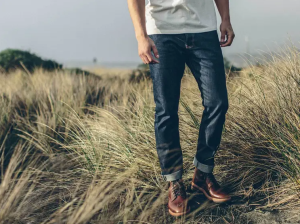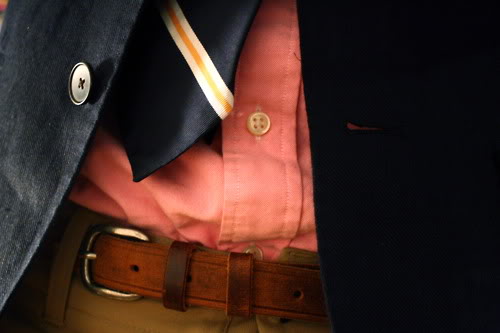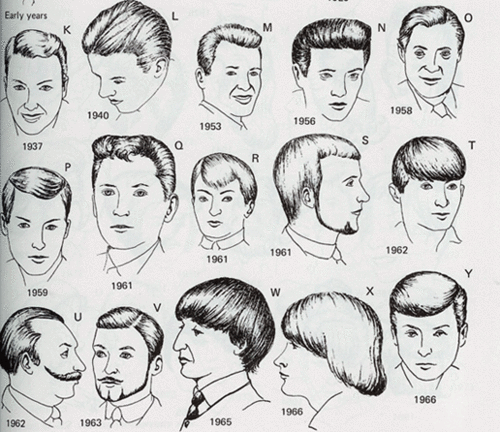“…they’re just jeans…”
Just beyond the fashion-conscious culture of designer jeans including the likes of diesel and true religion lies a niche denim culture, and it’s respective works of arts more artistic, subtle, expensive, and obsessive than anything you’ve seen before.
It’s a culture that includes terminology like “raw denim,” “organic denim,” and “selvage.” And it hails its heavy influences from one of the most obsessively unique epicenters of fashion, Japan.
Japanese Denim
If you call yourself a denim enthusiast, you are probably aware of “Japanese denim.” Although most of the mainstream is unaware, Japanese denim has a cult following amongst the fashion conscious because of its unique look, feel, and quality.
For style-obsessed Japanese who have the cash, a favorite pair of jeans is ultimately the most important item in a closet, surpassing the Fendi suit or the cashmere sweater from Prada. Brands may come and go but jeans are forever, and they are very, very personal. They will adorn you but they won’t disguise you, and they will surely reveal secrets of your innermost soul. – Kaori Shoji
You can see their culture of great attention-to-detail being applied to their denim, as Japanese denim makers go to great lengths, such as using traditional selvage looms to manufacture their denim. This labor-extensive process creates denim that is denser, yet surprisingly more comfortable than the mass-produced denim that we spot at the local Gap.
Mizra jeans, for example, are hand-made in Kyoto with details such as antique kimono fragments used on the pockets and hems. Even the dye is unique and organic, made from soy beans and wood charcoal. No two pair of Mizra jeans is the same.
So where do you find such art? For awhile, you could only find Japanese denim in Japan, but with the introduction of Japanese brands like Evisu, you can now find them in high-end boutiques, as well as boutiques. Cult Swedish brand Nudie also uses Japanese denim in their lines.
It seems Tokyo’s obsession with fashion is traveling fast into the States. Read Jae’s article, “What Asia Taught Me About Casual Style” to get a glimpse of the culture.
Selvage Denim (Selvedge Denim)
You hear a lot of talk amongst denim enthusiasts about “selvage” these days. Selvage denim is essentially a type of denim that forms a natural edge that does not unravel. The selvage edges will be located along the outseam of the pants, making it visible when cuffs are worn (as seen in the above picture). Selvage denim is desirable because it usually denotes a higher quality denim.
The word “selvage” comes from the phrase “self-edge” and denotes denim made on old-style shuttle looms. These looms weave fabric with one continuous cross thread (the weft) that is passed back and forth all the way down the length of the bolt. As the weft loops back into the edge of the denim it creates this “self-edge” or Selvage. Selvage is desirable because the edge can’t fray like lower grade denims that have separate wefts which leave an open edge that must be stitched. Shuttle looming is a more time-consuming weaving process that produces denim of a tighter weave resulting in a heavier weight fabric that lasts.
Raw Denim
Raw denim, or “dry denim,” is a denim that is not washed after the dying process. Most denim is washed after production in order to make it softer and reduce shrinkage. Also, non-raw (or non-dry) denim is also artificially “distressed” to achieve a certain look. Most of the jeans you find at stores with fades and artificial rips are examples of “non-dry” denim. Think of these types of jeans as your caramel lattes and raw denim as straight shots of espresso.
So why would anyone go for the plain-looking denim over its “cooler” counter-parts? The appeal in raw denim comes from the fact that with time the fabric fades in a manner similar to factory distressed denim. The fading is affected by the lifestyle of the person who wears it, giving it a more natural “character” that is a unique reflection of the wearer.
Organic Denim

You can think of “organic” denim like you do with “organic” foods. It is essentially denim made from 100% organic cotton, and as you will see below, other organic materials (such as the dye). Organic denim is devoid of pesticides and other chemicals, and thus, has quite the following with the eco-friendly.
A Look at the Process: Denim artisans work their art to create the finest denim
(courtesy of Sharkah Chakra Jeans)
Sharkah Chakra jeans are made only from fairtrade organic cotton
“Over one month our denim makers dip and sundry each hanks of white cotton up to 30 times into the natural indigo pots. This was how all fabric used to be dyed thousands of years ago. Reinvented for today this is what gives Sharkah Chakra denim its deep authentic blue tones…”
Pure indigo dye from the plant
Hand-woven on old-fashioned looms
Selvedge is seen here in fabric form. This traditional red and white selvedge taping is hand woven into the ends of the cloth to protect it from fraying.
The selvedge taping on the inside seam is a mark that the jeans were cut and tailored from the same piece of denim.
Organic pocketing……detailed simplicity.
To end off, here is a denim enthusiast’s list of brands known for exhibiting the aforementioned quality:
Nudie
A.P.C.
Ernest Sewn
Crate
KMW
Spurr
RRL
Simon Miller
Rag & Bone
Sugar Cane
Acne
45rpm
Evisu
Studio d’Artisan
After exploring this culture and it’s brands, I must admit that I can’t see jeans in the same way.
Ben





Loved the article, been wearing my raw denim nudies for 17 months now and the denim looks amazing. It’s really great to see that jeans become your own, and fit like a second skin. =)
p.s. if you want to see pics how raw denim turns out, just ask and i could mail you some pics.
Incredible useful. I’m printing out this list now for future reference.
Hi to Les Slackeur
I would like to see pics how raw denim turns out after wearing a long time also your Nudie jeans. I’m searching real roughest worn out raw denim items where all the pants or jackets are tellling thousands of stories during there aging process. No matter how poor condition, ugly, dirty, holess,…
Thanks for any answer and have a nice day
Ruedi Karrer
It’s the first time I commented here and I must say you share us genuine, and quality information for bloggers! Good job.
p.s. You have a very good template for your blog. Where did you find it?
Where can i purchase some selvage denim fabrics to taylor my own jeans? Hope somebody can assist me in this. Thank you.
Everybody is looking for the perfect pair of jeans, ones that accentuate their best features and disguise flaws. Locating the ideal pair of jeans is a tough job and with the dozens of choices that the market offers, the perfect pair that is flattering to your shape is almost impossible to find. Many of the world’s most noted fashion designers claim they make the perfect jean, but many fail. Bugle Boy Jeans are one line that has endured, in a market that is often fickle and fit’s perfect on my tiny frame.
can i buy only that fabric?? please email me
Hi All,
We’re a small bespoke denim shop in Los Angeles. Love the spotlight and informative post on denim. Many people often get caught up on the provenance of a denim, etc. At the end of the day, if the jeans fit you just right, that’s all that matters.
We do have a small stock of raw denim that we can sell by the yard, hit us up!